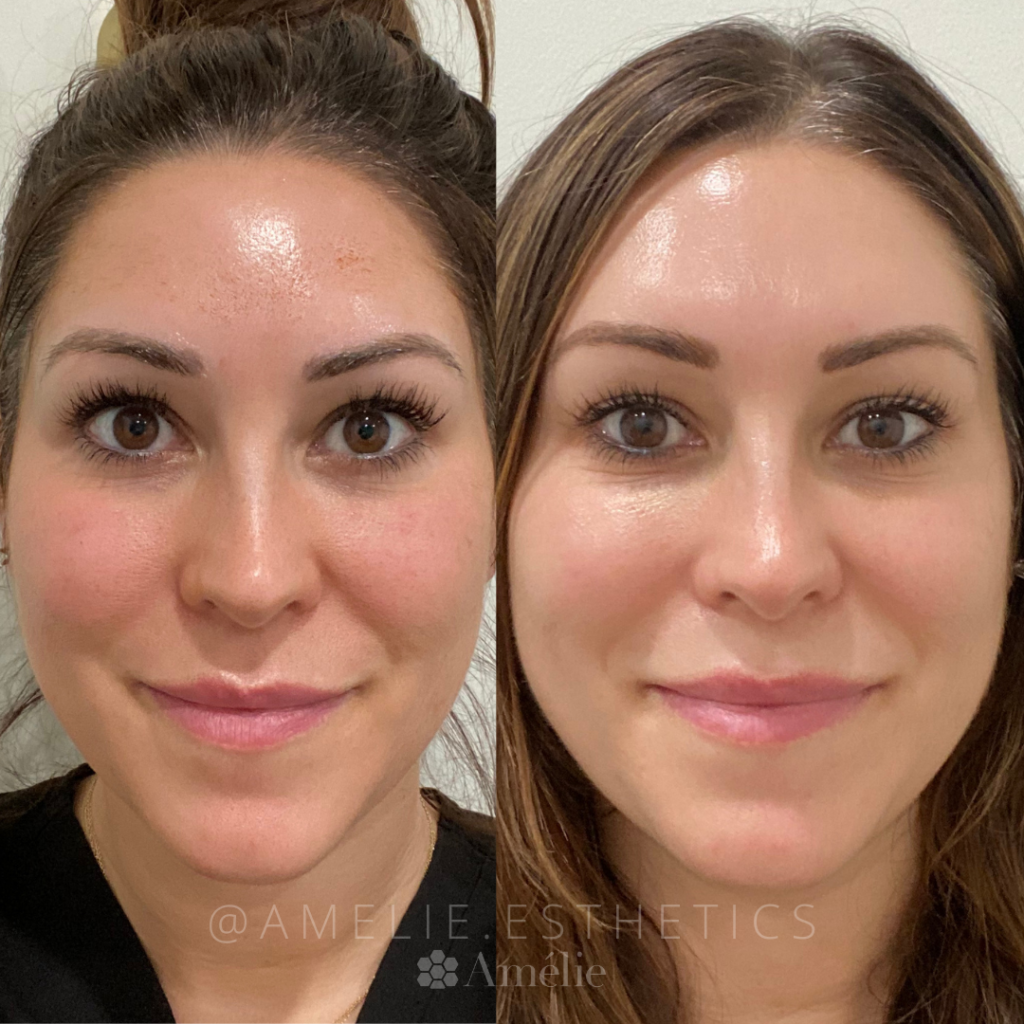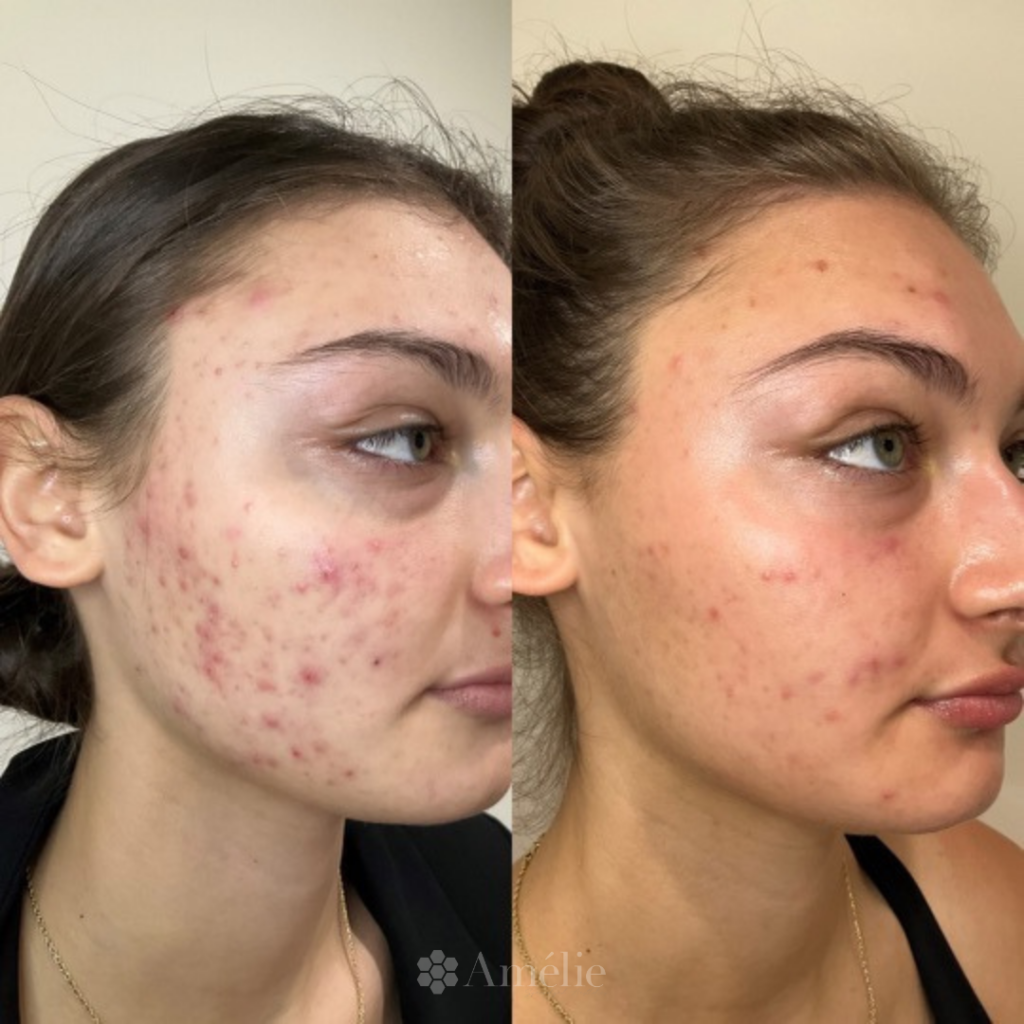CHEMICAL PEELS IN TIGARD, OR & VANCOUVER, WA
If you are experiencing active acne, sun damage, post inflammatory hyperpigmentation, acne scarring, melasma, or uneven tone and texture then a chemical peel might be a good option for you. Schedule an appointment with Amélie by phone or online to learn more.
What is a VIPeel?
A VIPeel is a medical-grade chemical peel designed to address a variety of skin concerns and improve overall skin health. It utilizes a proprietary blend of ingredients to promote exfoliation, improve skin texture, and reveal a more youthful complexion.
How Does a VIPeel Work?
A VIPeel works by applying a specialized chemical solution to the skin’s surface. This solution causes controlled exfoliation of the outermost layers of the skin, which encourages cell turnover and the regeneration of new, healthier skin cells.
What Skin Concerns Does a VIPeel Address?
A VIPeel is effective in treating a range of skin concerns, including fine lines, wrinkles, uneven skin tone, acne scars, hyperpigmentation, melasma, and sun damage. It can also improve the overall texture and clarity of the skin.
Is the VIPeel Treatment Safe?
Yes, a VIPeel is considered safe when performed by a trained and qualified skincare professional. The formula has been developed to minimize the risk of adverse reactions and complications.
How Many Sessions are Typically Recommended?
The number of sessions required varies depending on the specific skin concern and the desired results. Many clients achieve significant improvements after a single VIPeel treatment, while others may benefit from a series of treatments spaced several weeks apart.
Is There Any Downtime After the Treatment?
Downtime after a VIPeel treatment can vary depending on the depth of the peel and individual skin response. You may experience redness, peeling, and some mild discomfort for a few days to a week.
When Will I See Results?
Results from a VIPeel treatment can be noticeable within a week or two after the procedure. Full results will be seen after a series as the skin continues to heal and regenerate, improvements in texture, tone, and clarity become more apparent.
Can a VIPeel Be Combined with Other Treatments?
Yes, a VIPeel can be combined with other skincare treatments, such as microneedling or laser therapy, to enhance and customize results. Your skincare professional can recommend a personalized treatment plan based on your skin’s unique needs.
Is the Procedure Comfortable?
A VIPeel treatment involves a tingling or warming sensation as the chemical solution is applied to the skin. Some discomfort might be experienced during the procedure, but it is generally well-tolerated.
Who is a Good Candidate for VIPeel?
A VIPeel is suitable for individuals seeking to improve the appearance of various skin concerns, including signs of aging, hyperpigmentation, melasma, and uneven texture. A consultation with a trained skincare professional is necessary to determine if a VIPeel is appropriate for your skin type and goals.
BioRePeel
What is BioRePeel and How Does It Work?
An innovative treatment peel that dissolves bonds between cells that carefully removes the top layer of skin revealing the glowing smooth layer underneath. While exfoliating the skin surface, it also stimulates the production of collagen and elastin. It is a TCA 35% chemical peel that provides biostimulation and revitalization.
What Skin Concerns Does the BioRePeel Address?
The peel is suitable for all skin types, colors, and ages. It can also improve acne prone, congested skin, and skin with pigmentation and scarring (old or new).
How Many Sessions of the BioRePeel are Recommended?
We recommend 3-6 treatments spaced apart every 2 weeks for best results. 30 minute appointments.
Is the BioRePeel Safe?
Yes, a BioRePeel is considered safe when performed by a trained and qualified skincare professional. The formula has been developed to minimize the risk of adverse reactions and complications.
Is There Any Downtime After This Treatment?
The downtime associated with BioRePeel can vary depending on the specific formulation used, the individual’s skin type, and the depth of the peel. In general, BioRePeel has minimal to no downtime compared to more aggressive chemical peels.
Can the BioRePeel be Combined With Other Treatments?
Yes, a BioRePeel can be combined with other skincare treatments, such as microneedling or facial treatments to enhance and customize results. Your skincare professional can recommend a personalized treatment plan based on your skin’s unique needs.
Is the Procedure Comfortable?
The sensation experienced when BioRePeel is applied to the skin can vary from person to person, and individual sensitivity plays a role in how the treatment feels. Generally, BioRePeel is designed to be a gentle and well-tolerated procedure.
Who is a Good Candidate for the BioRePeel?
A VIPeel is suitable for individuals seeking to improve the appearance of various skin concerns, including signs of aging, acne, acne scarring, dullness, hyperpigmentation, melasma, and uneven texture. A consultation with a trained skincare professional is necessary to determine if a BioRePeel is appropriate for your skin type and goals.
TEAM
AMÉLIE
Meet the incredible team of aesthetics pros who live and breathe beauty—inside and out. We’re a family here, and when you visit us, you’re part of it! From our highly trained providers to our friendly and helpful support staff, we’re all obsessed with delivering an unparalleled experience and giving you results you can’t wait to show off.
LET’S GET STARTED
To book your free BOTOX consultation at Amélie, please call (503) 673-3893 or use our online scheduling tool. Our Tigard, OR and Vancouver, WA med spa welcomes people from all over the Portland area, including Tualatin, OR, and Vancouver, WA. We can’t wait to see you!



